MINI SIMMONS
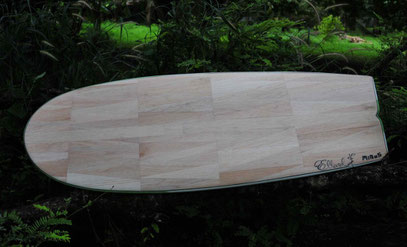

At first most people look at it a bit dubitative. For sure our eyes are not used (yet) to that kind of shape, especially the very wide tail. Some don't even want to try it, but who do, usually paddles back from the first wave with a smile and a bit of surpise in the eyes.
The feedback so far has been absolutely positive. Unbelievably fast, stable, easy to catch waves. Glides like a longboard, capable of big flowish cutbacks and above all a really fun ride. And
that's what surfing is all about right?!
Open your mind to the realm of possibilities…

"Q" 4 Quad
The Quad version is many's favorite.
High lining at incredible speed…
..and as the back fin plugs are set
where the twinnies usually are,
you can play it loose too.
"On my Minos Q Baan Baan crumbling sections and dwindling shoulders become a new playground for cut backs, lip whacks,
speed sections and amazing floaters. Oh, and you do get a wave with some punch you better wear your seat belt and goggles."
Devin ➸ #82

Also have a look at the "evolution". The "Egginos" another fast and fun planing hull with its round tail and quad fins setup.
Elleciel's Mini Simmons

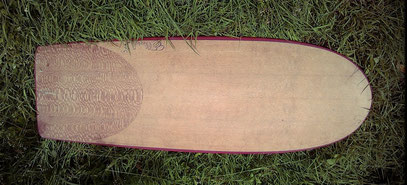
Midi Simmons

And who said that mini simmons are for small mushy waves
or small gutless surf only?!?
More about mini Simmons
"Coming out of the work of Simmons in the late 50′s and his adherence to the principles of even earlier boat hull theory, the concepts were rediscovered by Richard Kenvin as part of his Hydrodynamica project. Working with Joe Baugess from much longer simmons originals and referencing apocryphal stories of simmons riding a styrofoam 6 footer til the windansea shorebreak destroyed it, they first made a 9 foot replica in balsa. Kenvin and co. successfully rode this in large waves in both California and the Galapagos, then they went shorter.

The result was an epoxy 6 footer quite unlike anything else out there, a seemingly simple shape with decpetive subtleties. This first board was named “casper” after the friendly ghost and started to pop up in photos and videos around the net a couple of years ago. Having been ridden by a number of high profile surfers, all well documented with glowing ride reports the idea caught on and quickly many different shapers began to take the idea and put their own spin on it."...

"It’s definatley a board that draws lateral lines rather than truly vertical ones on the wave. The feel is probably best described as being like riding a bar of soap. It rolls from rail to rail smoothly and cuts through the water much like the feel of a hull. It’s a board you need to get low on as you
bottom turn and it feels great ina high line trim.

Where it differs from the hull is in turning.The fins are set well back, only a few centimetres from the tail and the board will pivot off the bottom or the top much like a normal twin keel fish. Once you outrun a section it cuts back like a skatey loose fish so you can set up for the next speed run, then repeat til your grinning like a loon and hooting yourself!"...
Even Mr. Slater..
"After snapping his board, Kelly took interest in this funky little two-fin and borrowed it from a lucky local punter."

"The Simmons surfboard is as strange an apparition today as when it first appeared. In its time it broke all rules of the day. It represents a shift from heavy displacement to light displacement
along with the application of scientific theory. It was a radical departure, far ahead of its time, like the designer, and misunderstandings hindered its full acceptance. Bob Simmons disregarded
criticism and just went surfing, which was his great love; his surfing proved the validity of his boards along with their use by a small cadre of followers.
From what he said and the body of research in his possession, along with a visual appraisal, one can get an idea of what he was pursuing. He was an aerodynamicist and a mathematician. That
viewpoint must be kept in mind.
The boards had maximum width. Width was favored for the least resistance. Width plays a key role in delivering kinetic energy to the airfoil rail, the leading edge, that gives deflection. All
planing hulls are deflectors. The airfoil is a special shape that is calculated. Width divided into length is aspect ratio, giving a magic number related to lift. Width also allows the hull to
leave a clean wake. An impressive example of the value of width is the bodyboard.

The wide, unusually cambered, uplifted noses created a lot of criticism. The unknowing critics said they were pushing water, but they were in fact working, spreading the water momentarily, to the
high pressure rails before take off. In a tough spot, where the nose comes into contact with the water, in a steep take off or large chop, they lifted. Changing the noses was not a big deal to
him, saying they stick out when we surf. He rejected points as too fragile and dangerous. Some of his early boards had points...
The outlines were fair parallelism, contiguous rails, fared-in near the tail for clean stable running. Non-uniform outline shapes were rejected because of eddy flow resistance that increases with
planing speed. This occurs at 10" in width. He is on record that trying to modify paddleboard shapes into surfboards was wrong; destroying the wide tail reduced early lift and clean resistance
wakes. Those forms pulled the rail away from the wave and required a single fin, partly corrected with a tri fin today, which undoubtedly would have been rejected, because of increased appendage
drag*. Rocker was rejected for reasons made obvious by his theory. 'Ya just don't need it!"
He rejected the notion that wide tails were the cause of 'spin-out" and considered it a fin problem. He moved a small fin to each outboard rail at the end and towed them in to 10 degrees. This is
because the water is moving fastest at these points as it leaves the hull. A single centered fin is in the low pressure area of the board and away from the wave. He simply expressed, you need
more fin at low speeds and less at high speeds. Simmons and his "test pilots" never spun out with dual fins, surfing the biggest and hardest breaking surf...He noted with criticism that narrow
tails give a tubing, sucking wake. Anything that had eddy flow resistance was a "disaster" and "not the way to go!"
- John Elwell
from "Interpreting the Simmons Board"
published in the Surfers Journal
1994
* Simmons suggested to Bev Morgan that he try a 6'0" tri-fin.












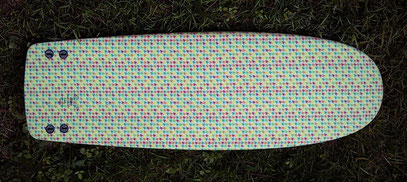
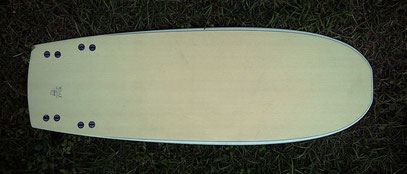


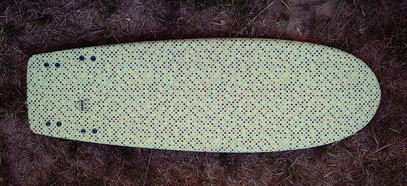


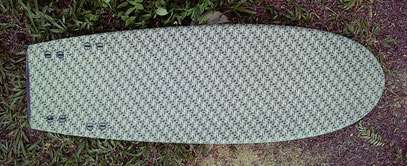







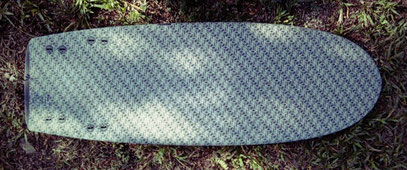


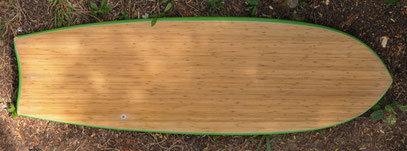

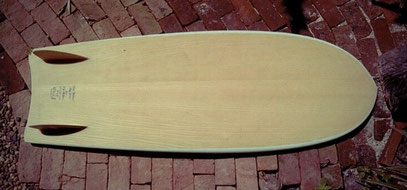



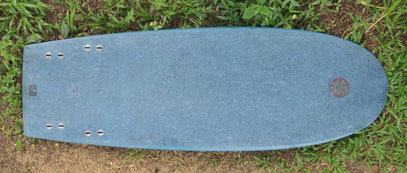



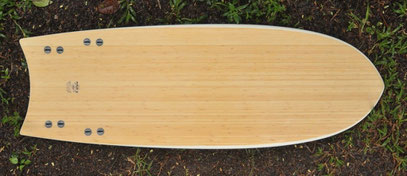


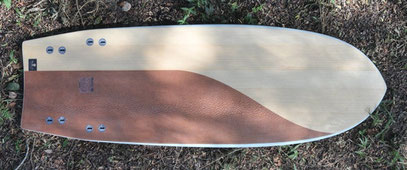






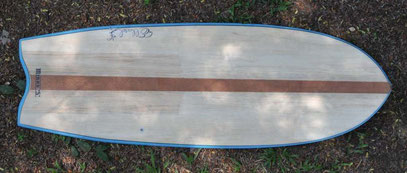



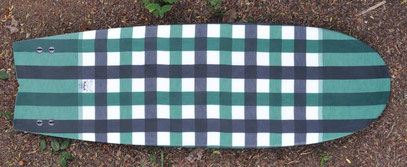
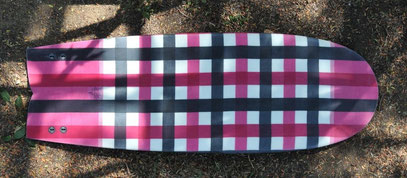


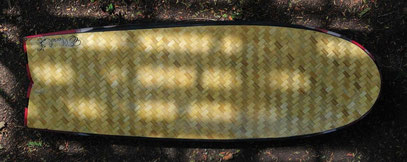


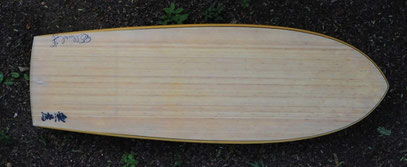


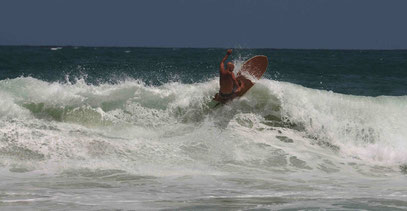

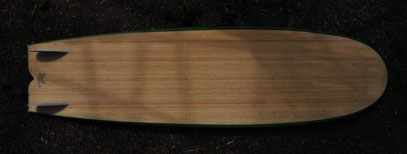



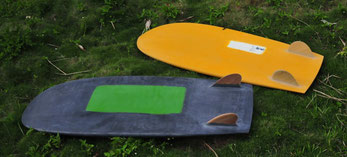
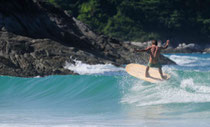



























Write a comment
J.Welch (Sunday, 29 January 2012 19:04)
I took the "Baan BaaN" #46 to Bali on my last surf fling. I surfed Balian and while I could have used more board for paddling, the mini simmons proved to skate fluidly through and over most all sections of the wave. The slight kick that Dave incorporated in the tail rocker is a must for finding not only the burst of speed when needed, but also I found it an advantage when trying to redirect in tight turns. I would say the only draw back to the shape was chatter and skip when dealing high speed over bumpy wave surface. But this is not a reflection on Davies boards as much as is knowing what board to use in a given conditions. Suffice to say that I have surfed another simmons like board from Dave and the concept/design works well and has had me smiling and stoked on many days.
Dave my next order is coming soon.
Devin (Sunday, 16 September 2012 20:48)
Been surfing since 86 and never gave the Mini Simmons a thought until i saw the way David and friends were having a blast ripping up the un-rip-able mush pot that is Phuket. I love surfing there but seriously, the waves are mush and have no power even on the big days.. On my Minos Q Baan Baan crumbling sections and dwindling shoulders become a new playground for cut backs, lip whacks,
speed sections and amazing floaters. Oh, and you do get a wave with some punch you better wear you seat belt and goggles. Simply put the most fun i ever had on 4 fins !! Crafted from start to finish with love and positive action, this is one for my epic memory book of surfing :)
..Oh and sorry I not English major haha!